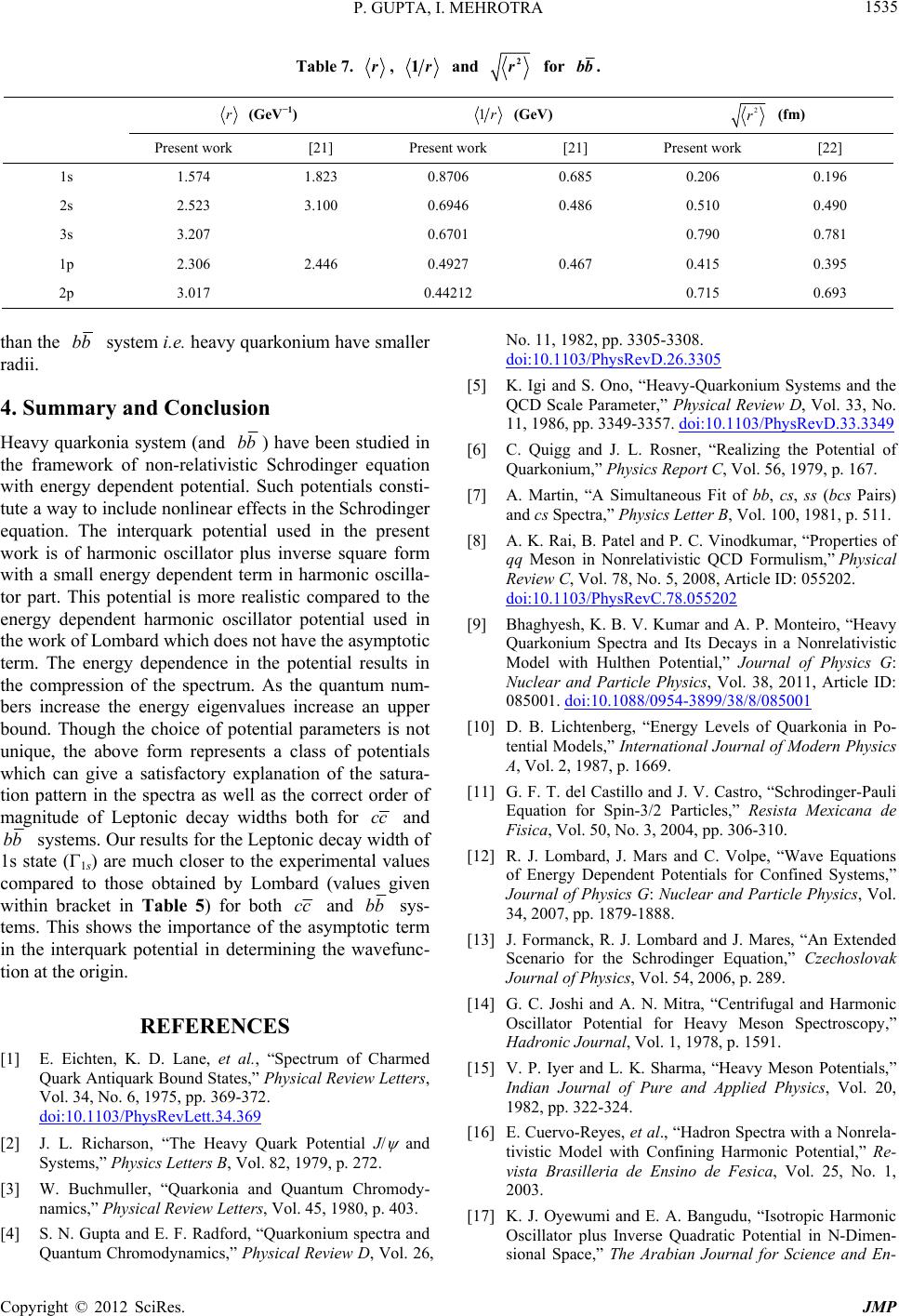
P. GUPTA, I. MEHROTRA 1535
Table 7. r, 1r and 2
r for bb .
r (GeV−1) 1r (GeV) 2
r (fm)
Present work [21] Present work [21] Present work [22]
1s 1.574 1.823 0.8706 0.685 0.206 0.196
2s 2.523 3.100 0.6946 0.486 0.510 0.490
3s 3.207 0.6701 0.790 0.781
1p 2.306 2.446 0.4927 0.467 0.415 0.395
2p 3.017 0.44212 0.715 0.693
than the bb system i.e. heavy quarkonium have smaller
radii.
4. Summary and Conclusion
Heavy quarkonia system (and bb) have been studied in
the framework of non-relativistic Schrodinger equation
with energy dependent potential. Such potentials consti-
tute a way to include nonlinear effects in the Schrodinger
equation. The interquark potential used in the present
work is of harmonic oscillator plus inverse square form
with a small energy dependent term in harmonic oscilla-
tor part. This potential is more realistic compared to the
energy dependent harmonic oscillator potential used in
the work of Lombard which does not have the asymptotic
term. The energy dependence in the potential results in
the compression of the spectrum. As the quantum num-
bers increase the energy eigenvalues increase an upper
bound. Though the choice of potential parameters is not
unique, the above form represents a class of potentials
which can give a satisfactory explanation of the satura-
tion pattern in the spectra as well as the correct order of
magnitude of Leptonic decay widths both for cc and
bb systems. Our results for the Leptonic decay width of
1s state (1s) are much closer to the experimental values
compared to those obtained by Lombard (values given
within bracket in Table 5) for both cc and bb sys-
tems. This shows the importance of the asymptotic term
in the interquark potential in determining the wavefunc-
tion at the origin.
REFERENCES
[1] E. Eichten, K. D. Lane, et al., “Spectrum of Charmed
Quark Antiquark Bound States,” Physical Review Letters,
Vol. 34, No. 6, 1975, pp. 369-372.
doi:10.1103/PhysRevLett.34.369
[2] J. L. Richarson, “The Heavy Quark Potential J/
and
Systems,” Physics Letters B, Vol. 82, 1979, p. 272.
[3] W. Buchmuller, “Quarkonia and Quantum Chromody-
namics,” Physical Review Letters, Vol. 45, 1980, p. 403.
[4] S. N. Gupta and E. F. Radford, “Quarkonium spectra and
Quantum Chromodynamics,” Physical Review D, Vol. 26,
No. 11, 1982, pp. 3305-3308.
doi:10.1103/PhysRevD.26.3305
[5] K. Igi and S. Ono, “Heavy-Quarkonium Systems and the
QCD Scale Parameter,” Physical Review D, Vol. 33, No.
11, 1986, pp. 3349-3357. doi:10.1103/PhysRevD.33.3349
[6] C. Quigg and J. L. Rosner, “Realizing the Potential of
Quarkonium,” Physics Report C, Vol. 56, 1979, p. 167.
[7] A. Martin, “A Simultaneous Fit of bb, cs, ss (bcs Pairs)
and cs Spectra,” Physics Letter B, Vol. 100, 1981, p. 511.
[8] A. K. Rai, B. Patel and P. C. Vinodkumar, “Properties of
qq Meson in Nonrelativistic QCD Formulism,” Physical
Review C, Vol. 78, No. 5, 2008, Article ID: 055202.
doi:10.1103/PhysRevC.78.055202
[9] Bhaghyesh, K. B. V. Kumar and A. P. Monteiro, “Heavy
Quarkonium Spectra and Its Decays in a Nonrelativistic
Model with Hulthen Potential,” Journal of Physics G:
Nuclear and Particle Physics, Vol. 38, 2011, Article ID:
085001. doi:10.1088/0954-3899/38/8/085001
[10] D. B. Lichtenberg, “Energy Levels of Quarkonia in Po-
tential Models,” International Journal of Modern Physics
A, Vol. 2, 1987, p. 1669.
[11] G. F. T. del Castillo and J. V. Castro, “Schrodinger-Pauli
Equation for Spin-3/2 Particles,” Resista Mexicana de
Fisica, Vol. 50, No. 3, 2004, pp. 306-310.
[12] R. J. Lombard, J. Mars and C. Volpe, “Wave Equations
of Energy Dependent Potentials for Confined Systems,”
Journal of Physics G: Nuclear and Particle Physics, Vol.
34, 2007, pp. 1879-1888.
[13] J. Formanck, R. J. Lombard and J. Mares, “An Extended
Scenario for the Schrodinger Equation,” Czechoslovak
Journal of Physics, Vol. 54, 2006, p. 289.
[14] G. C. Joshi and A. N. Mitra, “Centrifugal and Harmonic
Oscillator Potential for Heavy Meson Spectroscopy,”
Hadronic Journal, Vol. 1, 1978, p. 1591.
[15] V. P. Iyer and L. K. Sharma, “Heavy Meson Potentials,”
Indian Journal of Pure and Applied Physics, Vol. 20,
1982, pp. 322-324.
[16] E. Cuervo-Reyes, et al., “Hadron Spectra with a Nonrela-
tivistic Model with Confining Harmonic Potential,” Re-
vista Brasilleria de Ensino de Fesica, Vol. 25, No. 1,
2003.
[17] K. J. Oyewumi and E. A. Bangudu, “Isotropic Harmonic
Oscillator plus Inverse Quadratic Potential in N-Dimen-
sional Space,” The Arabian Journal for Science and En-
Copyright © 2012 SciRes. JMP